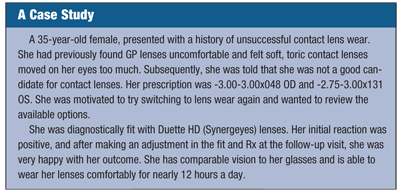 Thanks to a renewed interest in contact lens research, we are now seeing the unveiling of new several specialty lens options. With advanced technologies that allow an individualized approach, eye care practitioners now have the ability to expand the contact lens population, reaching patients who may have previously been unable to wear lenses. For our current patients, we can provide an optimal wearing experience that minimizes the chances of dropout.
Thanks to a renewed interest in contact lens research, we are now seeing the unveiling of new several specialty lens options. With advanced technologies that allow an individualized approach, eye care practitioners now have the ability to expand the contact lens population, reaching patients who may have previously been unable to wear lenses. For our current patients, we can provide an optimal wearing experience that minimizes the chances of dropout.
Our patient’s expectations, however, can be the difference between success and failure when fitting specialty—particularly astigmatic and multifocal—contact lenses. Careful communication with each patient will orient and clarify expectations and help the experience get off to a good start. By contrast, careless or off-the-cuff explanations that fail to set realistic expectations might torpedo the entire experience.
This column will discuss how to interact with your patients, as well as provide a framework for obtaining information and providing feedback, to lay the groundwork for success.
Pre-Fit Consultation
At the pre-fitting appointment, identify your patient’s occupation, hobbies and daily visual requirements. This will help you provide your patient with the most comprehensive information about available options. Use this opportunity to gauge your patient’s interest and offer an overview of the expected fitting timeline (e.g., customizing the prescription and fit) and the corresponding fees. Take the time to describe the specialty process of the technology you plan to fit. Collect and record a thorough history—knowing your patient’s past lens experience can help you decide what may be a better fit.
 As an eye care professional, it is important to maintain a fully operational tool bag; stay abreast of the latest developments in contact lens technology, including specialty toric, multifocal, hybrid, rigid gas-permeable and scleral designs. Present all of these options in a positive way while setting realistic expectations.
As an eye care professional, it is important to maintain a fully operational tool bag; stay abreast of the latest developments in contact lens technology, including specialty toric, multifocal, hybrid, rigid gas-permeable and scleral designs. Present all of these options in a positive way while setting realistic expectations.
Continue the consultation by discussing appropriate visual expectations and stressing the importance of follow-up care. Try to describe the basics of the design, and the anticipated time it would take for the fitting, fabrication, shipping and subsequent progress visits with the new custom-made lenses.
Presbyopia Discussion
When discussing presbyopic contact lens fittings, avoid using the terms compromised or loss of visual clarity in your communication. Instead, add a positive spin: Describe multifocal lenses as a customized approach to each patient’s visual system and daily visual demands. Be upfront about the challenges, and the rewards. Identify stressors, such as the phone book or medicine labels, that likely will be difficult to read, but also explain how these lenses will eliminate their need for reading glasses 90% of the time.
Spend time going over the technology, and explain how the vision design delivers near, intermediate and distance correction simultaneously. The multifocal lenses have more of a gradual change between viewing zones vs. the “jump” between zones that comes with translating designs. When beginning to fit a patient, let them know you may err on the side of better distance vision, but will improve the near area as the fitting process continues.
Explaining Astigmatism
Unfortunately, many patients don’t have a solid understanding of what astigmatism means. Some even associate the word with a disease. As the eye care practitioner, start by explaining that astigmatism is simply a different way of focusing images, and debunk the prevalent misconception that astigmatic patients can’t wear contact lenses. Then discuss the latest breakthroughs in technology to best meet their visual needs.
Today’s contact lens industry has increased our ability to provide a customized lens for a specific prescription, even for patients with high amounts of astigmatism and oblique astigmatic needs. Toric multifocal or GP lenses are available options for presbyopic patients with astigmatism. Reach out to your lab consultants for advice on these fits.
Hybrid technology is an excellent example of how material science can help those with unique visual needs comfortably wear contact lenses. For astigmatic patients, these designs provide better visual acuity with comfort comparable to soft contact lenses. A fitting set is great, but can be ordered empirically.
The biggest challenge for eye care practitioners is deciding which technology will work best. When talking your patients, be sure to reiterate that if one lens is not the best fit, you will try something else. Outline how you gauge success, thank them in advance for their patience and charge them appropriately for your time and expertise. Remember to be flexible and commit the time initially to make slight adjustments as needed. Even a small change in a prescription can make a large improvement in your patient’s visual abilities.
Several soft, RGP and hybrid contact lens options available today may provide better optics and comfort to our patients, allowing us to reach previously untapped demographics. This, in turn, will translate to new referrals and increased profitability for your practice. In order to successfully incorporate these specialized contact lens services into your practice, education is key. Understand the different materials and designs on the market and review the recommended fitting guides to best address your patient’s needs.


